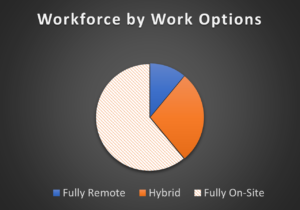There seems to be a mismatch between jobseeker expectations about fully remote opportunities and the reality that most companies are no longer seeking 100% remote.
During the pandemic, fully remote work was a life saver for both companies and employees. Work could be handled without concern of exposure to covid by working from home. Now that we are a few years beyond covid, being fully remote isn’t needed to keep the business running plus many companies have found significant issues with fully remote.
I was on a call last week with 7 recruiting companies and no one has been receiving fully remote job orders for quite some time, yet they still have jobseekers inquiring daily about fully remote work. Many of these recruiting companies from across the United States acknowledge they still have job orders for hybrid remote for certain types of positions. Most of the hybrid positions are 2 or 3 days remote with the remainder in the office. Hybrid offers a good bridge between employee engagement and performance and flexibility and could be the answer for certain types of positions, but the jury is still out. Many companies recognize Gen Z’s lack of soft skills have left the fully remote option quite unattractive since in-office work skills can only be gained there. Even many Gen Z people understand their career would benefit from in-office work and experience.
I equate fully remote to the home gym. The idea sounds wonderful. You don’t have to waste commuting time to get a workout and don’t have to pay monthly fees. But the reality of a home gym is many people cannot motivate themselves to work quite as hard as they do in a gym. There are no people to notice if you slack off. Yard sales are full of home gym equipment for that reason.
During these difficult hiring times, why aren’t businesses continuing this fully remote option when it would make hiring much easier?
1. Poor Workplace Communication– Lack of in-person interaction can lead to miscommunication and make the workers feel disconnected. Quick discussions, normal in an office setting, are abandoned. Who is going to call someone to mention one passing thought?
2. Job Performance– It is very easy to tend to household items, television, errands or even children when working from home. When we inquire why the jobseeker wants fully remote, often the reason is small children or children home from school in the afternoon. How then can the worker be productive when tending to children? According to WFH Research (1), fully remote work results in 10-20% lower productivity than fully in-person work.
Consider your own experience. How often have you emailed to solve an issue and find the time it takes is much longer? When I inquired at a CEO Roundtable, everyone unanimously pointed to remote work. Why, if someone is working remotely, does the response time increase? Because they are not working their normal full day.
In an Economic report I read daily from Armada, written by Chris Kuehl and Keith Prather whom I think of highly, mentioned that total workers working two or more jobs is just 5% of the total workforce which is right at the decade long average. The interesting part is those working two full-time jobs as opposed to one full-time and a part-time job continues to increase. Based on their writing, people working a remote full-time job are only working 15-20 hours of actual time which allows them to hold a “secret” second job. This is a rather minute part of the workforce but is interesting.
If you google this topic of fully remote work, you will see many conflicting articles and stats. I think the reason is early in the pandemic, remote workers were more productive because the situation was new, the health scare was real, and they were thankful to have a position when many lost their jobs. Over time, human nature creeps in and less work gets accomplished in a day. I believe strong workplace relationships became weaker over time and companies saw the team approach waning.
One stat from Finmasters (2), dated April 2023, indicated the following stats. Fully remote is the smallest piece of the pie at just 11% of the workforce. (It has been declining since January 2022.) Hybrid as the orange slice is just at 28% of the workforce.
While hiring for your jobs, there is going to be a constant need for education about fully remote possibilities and the needs of your company. When possible, hybrid may be a nice bridge even if it is only one day per week. Matching the jobseeker with their need for flexibility to the company’s need for full-time work productivity will continue to be a constant struggle.
Sources:
(1) https://www.indeed.com/career-advice/news/team-productivity-remote-work#:~:text=According%20to%20data%20compiled%20by,II%E2%80%94about%2080%20years%20ago.
(2) https://finmasters.com/how-many-americans-work-from-home/?gclid=EAIaIQobChMIn6G10J7hgAMVFPWUCR13cQBjEAAYAiAAEgLYcPD_BwE
